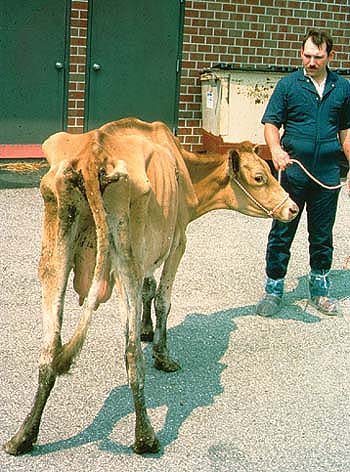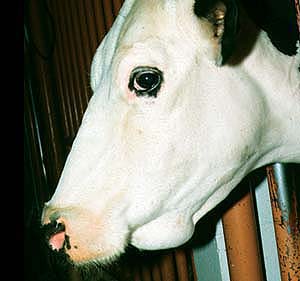All Issues
Preventing Johne's disease is good all-around dairy practice
Publication Information
California Agriculture 58(3):137-137.
Published July 01, 2004
PDF | Citation | Permissions
Full text
About one-fifth of U.S. dairies have cows with Johne's disease, but in 1997 nearly half of the nation's dairy producers were unaware of this bacterial illness, which can cause chronic diarrhea, wasting and ultimately cattle death. California dairy workers who have participated in a voluntary educational program on controlling Johne's (“Yo-knees”) disease are both more aware of this illness and more likely to do something about it, according to a 2003 survey of participants by John Kirk, UC Cooperative Extension (UCCE) veterinarian.
Also called paratuberculosis because it is caused by the slow-growing bacterium Myobacterium avium paratuberculosis (Map), Johne's disease primarily affects the digestive systems of cows and other ruminant animals. The disease can decrease milk production, and increase mastitis and reproductive disorders. Afflicted cows usually catch the disease as newborn calves via manure, colostrum or milk but have no symptoms until they are at least 3 years old.
Because California dairies generally do not keep cows long enough for the disease to manifest, it has little apparent economic impact on them. Even so, controlling the disease is in the dairy industry's best interests. Johne's disease is somewhat similar to the human Crohn's disease, a chronic inflammatory bowel disease that likewise causes chronic diarrhea and weight loss, and has no cure. While the cause of Crohn's disease is unknown, some fear that people can catch it by drinking cow's milk.
Studies to date have yielded conflicting results and there is not enough evidence to prove or disprove a link between the two diseases, according to a 2003 National Academies of Science report. “It seems biologically plausible that Map could cause at least a subset of Crohn's disease,” the report stated. “If evidence of a link were found, it would transform Johne's disease into a serious public-health problem.” At this time, Johne's is considered a cattle disease and Crohn's a human disease.
To help control the disease, in 1999 the California Johne's Disease Advisory Council established a 1-hour educational program as part of the California Dairy Quality Assurance Program. Initially presented by UC Davis Veterinary Medicine Extension faculty, the Johne's disease educational program is now also presented by 150 certified private-practice veterinarians.
A followup survey of 27 participants showed that many have begun implementing measures for controlling Johne's disease. For example, the survey found that 92% are now looking for cows with symptoms of the disease; 86% are cleaning calving areas more frequently; and 60% are removing calves from the calving area before they begin to nurse. These measures are important because in most cases calves are infected soon after birth by ingesting manure or nursing from manure-covered teats.
However, some control measures were not as likely to be adopted. For example, while Johne's disease can also be transmitted in milk, more than half of the participants were doubtful about feeding calves pasteurized milk. This may be due to the high cost of effective pasteurization equipment, which ranges from $20,000 to $40,000. “Most dairymen have initiated control measures that require only a change in attitude or management without major costs,” Kirk says.
Cows with advanced Johne's disease, a chronic wasting disease transmitted by manure, usually do not show symptoms until they are at least 3 years old. Signs of Johne's disease include chronic diarrhea and weight loss. Typically, affected animals remain bright and alert, without fever, and eating well.
“Bottle jaw,” also called submandibular edema, is another sign of Johne's disease. A UC Cooperative Extension short course teaches dairy operators the clinical signs of Johne's disease, as well as how to prevent it.
In addition, the surveyed participants were split on using blood tests or fecal cultures to gauge the prevalence of Johne's disease in their herds. “This probably reflects the general feeling among California dairymen that this disease is of insignificant economic impact on their dairies,” Kirk says.
However, measures to control Johne's disease can also benefit dairies by controlling other diseases. “Many dairy diseases are passed in manure or milk to newly born calves, says Kirk. “All Johne's disease control and prevention measures that reduce manure and milk transmission to calves will also reduce other diseases such as salmonellosis and mastitis.”






